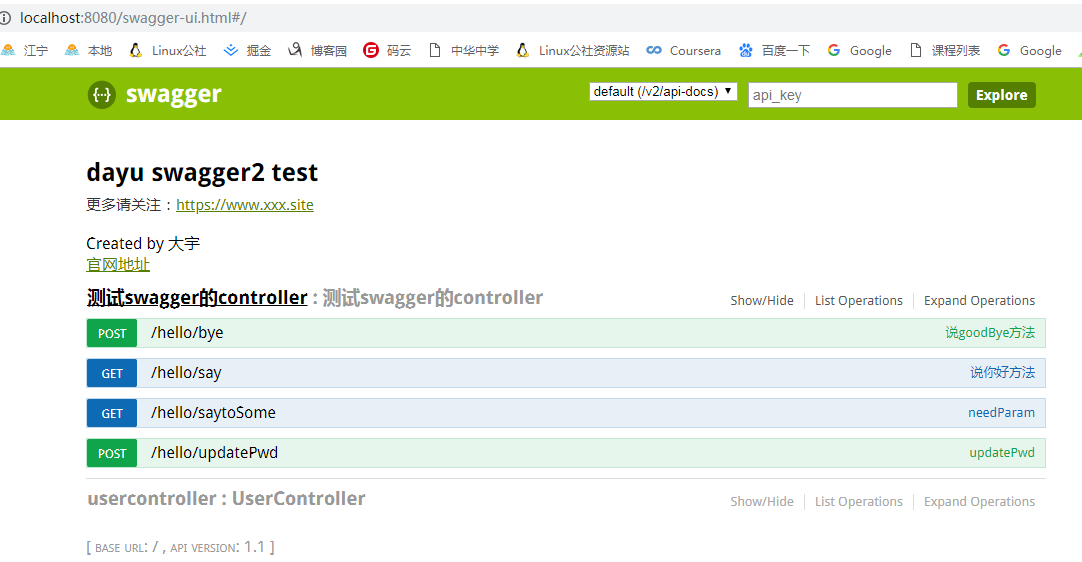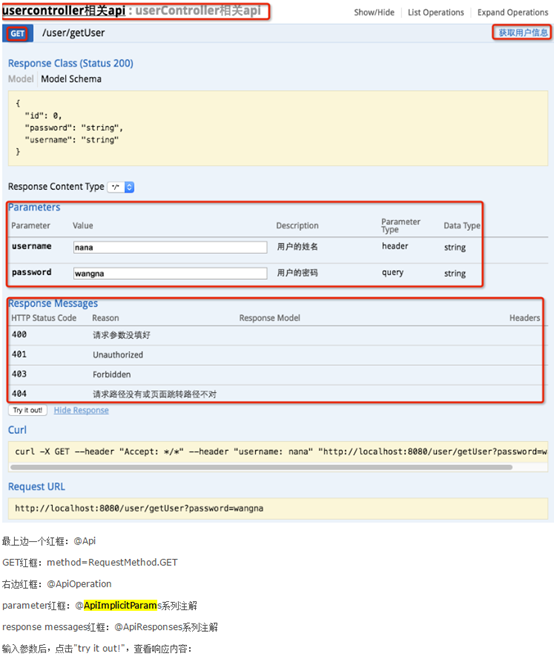springboot搭建Swagger api文档的测试demo
Swagger官网地址:https://swagger.io
Swagger是一款rest api文档生成工具。
Swagger可以生成一个具有互动性的API控制台,开发者可以快速学习和尝试API
可以生成客户端SDK代码用于各种不同的平台上的的实现
Swagger文件可以在许多不同的平台上从代码注释中自动生成
本demo记录springboot集成Swagger2的使用步骤。
1、首先创建一一个springboot项目,项目中 引用Swagger依赖包
<dependency> <groupId>io.springfox</groupId> <artifactId>springfox-swagger2</artifactId> <version>2.2.2</version> </dependency> <dependency> <groupId>io.springfox</groupId> <artifactId>springfox-swagger-ui</artifactId> <version>2.2.2</version> </dependency>
在启动类的统计包下创建Swagger的配置类
package com.swagger; import org.springframework.context.annotation.Bean; import org.springframework.context.annotation.Configuration; import springfox.documentation.builders.ApiInfoBuilder; import springfox.documentation.builders.PathSelectors; import springfox.documentation.builders.RequestHandlerSelectors; import springfox.documentation.service.ApiInfo; import springfox.documentation.spi.DocumentationType; import springfox.documentation.spring.web.plugins.Docket; import springfox.documentation.swagger2.annotations.EnableSwagger2; /** * @author dayu * @create 2019/3/12 10:39 * @Description 配置类或者在类上添加扫描包的位置注解 */ @Configuration @EnableSwagger2 public class Swagger2 { /** * 创建API应用 * apiInfo() 增加API相关信息 * 通过select()函数返回一个ApiSelectorBuilder实例,用来控制哪些接口暴露给Swagger来展现, * 本例采用指定扫描的包路径来定义指定要建立API的目录。 */ @Bean public Docket createRestApi() { return new Docket(DocumentationType.SWAGGER_2) .apiInfo(apiInfo()) .select() //指定扫描的包 .apis(RequestHandlerSelectors.basePackage("com.swagger.controller")) //.apis(RequestHandlerSelectors.any()) .paths(PathSelectors.any()) .build(); } /** * 创建api基本信息,会显示在页面文档中 */ private ApiInfo apiInfo() { return new ApiInfoBuilder() .title("dayu swagger2 test") .description("更多请关注:https://www.xxx.site") .license("官网地址") .licenseUrl("https://www.xxx.site") .contact("大宇") .version("1.1") .build(); } }
三:添加文档类容
上述的配置已经可以生产文档了,但是默认的配置文档都是函数名本身,对测试或者开发者来说并不太友好,所有需要对每个方法添加一些说明来解释具体步骤或者功能
Swagger使用的注解说明:
- @Api 用在类上,说明类的作用
- @ApiOperation 在方法上,里面有方法说明
- @ApiImplicitParams 用在方法上,由多组@ApiImplicitParam参数说明组成
- @ApiImplicitParam 用在方法上,说明方法中的一个参数说明
- @ApiResponses 用于表示一组响应
- @ApiResponse:用在@ApiResponses中,一般用于表达一个错误的响应信息,code:数字,如400,message:信息,如“请求参数没填好”,response:抛出异常的类
- @ApiModel:描述一个Model的信息(一般用在请求参数无法使用@ApiImplicitParam注解进行描述的时候)
- @ApiModelProperty:描述一个model的属性
注意:@ApiImplicitParam的参数说明:
|
paramType:指定参数放在哪个地方 |
header:请求参数放置于Request Header,使用@RequestHeader获取 query:请求参数放置于请求地址,使用@RequestParam获取 path:(用于restful接口)-->请求参数的获取:@PathVariable body:(不常用) form(不常用) |
|
name:参数名 |
|
|
dataType:参数类型 |
|
|
required:参数是否必须传 |
true | false |
|
value:说明参数的意思 |
|
|
defaultValue:参数的默认值 |
|
demo:
package com.swagger.controller;
import io.swagger.annotations.Api;
import io.swagger.annotations.ApiImplicitParam;
import io.swagger.annotations.ApiImplicitParams;
import io.swagger.annotations.ApiOperation;
import org.springframework.util.StringUtils;
import org.springframework.web.bind.annotation.RequestMapping;
import org.springframework.web.bind.annotation.RequestMethod;
import org.springframework.web.bind.annotation.RestController;
import javax.websocket.server.PathParam;
/**
* @author dayu
* @Description 注意@ApiImplicitParam的使用会影响程序运行,如果使用不当可能造成控制器收不到消息
*/
@RestController
@RequestMapping("/hello")
@Api(value = "测试swagger的controller")
public class HelloController {
@RequestMapping(value = "say", method = RequestMethod.GET)
@ApiOperation(value = "说你好方法", notes = "输入就可以说hello")
public String say() {
System.out.println("HelloController.say");
return "HelloController.say hello swagger2.0";
}
@RequestMapping(value = "saytoSome", method = RequestMethod.GET)
@ApiOperation(value = "needParam", notes = "添加参数")
@ApiImplicitParam(paramType = "query", value = "姓名", name = "name", required = true, dataType = "String")
public String saytoSome(@PathParam(value = "name") String name) {
if (StringUtils.isEmpty(name)) {
return "无人区";
}
if (name.equals("xiaoming")) {
return "是个好人";
} else {
return "hello " + name;
}
}
@RequestMapping(value = "bye", method = RequestMethod.POST)
@ApiOperation(value = "说goodBye方法", notes = "输入就可以说再见")
public String bye() {
System.out.println("HelloController.byebye");
return "byebye swagger2.0";
}
@ApiOperation(value = "updatePwd",notes = "更改密码")
@ApiImplicitParams({
@ApiImplicitParam(paramType = "query",name = "userId",value = "用户名",required = true,dataType = "Integer"),
@ApiImplicitParam(paramType = "query",name = "password",value = "旧密码",required = true,dataType = "String"),
@ApiImplicitParam(paramType = "query",name = "newPassword",value = "新密码",required = true,dataType = "String"),
})
@RequestMapping(value = "updatePwd", method = RequestMethod.POST)
public String updatePwd(Integer userId, String password, String newPassword) {
if(userId<=0 ||userId>5){
return "用户id错误";
}
if (StringUtils.isEmpty(password) || StringUtils.isEmpty(newPassword)) {
return "密码不能为空";
}
if (password.equals(newPassword)) {
return "密码不能相同!";
}
return "密码修改成功!";
}
}
四: 启动项目,直接方法swagger-ui的页面即可进入主页
地址:http://localhost:8080/swagger-ui.html

需要注意的两点:
1、 @ApiImplicitParam中的属性paramType会直接影响程序的运行期,如果paramType与方法参数获取使用的注解不一致,会直接影响到参数的接收。
2、Conntroller中定义的方法必须在@RequestMapper中显示的指定RequestMethod类型,否则SawggerUi会默认为全类型皆可访问, API列表中会生成多条项目。
Swagger UI面板说明:

五、测试接收对象的参数
注意: 在后台采用对象接收参数时,Swagger自带的工具采用的是JSON传参,测试时需要在参数上加入@RequestBody,正常运行采用form或URL提交时候请删除。
对象类上需要添加api注解
package com.swagger.pojo; import io.swagger.annotations.ApiModel; import io.swagger.annotations.ApiModelProperty; @ApiModel(value = "人物模型") public class User { @ApiModelProperty(name = "userId", value = "人物id", required = true) private Integer userId; @ApiModelProperty(value = "人物姓名", required = true) private String name; public Integer getUserId() { return userId; } public void setUserId(Integer userId) { this.userId = userId; } public String getName() { return name; } public void setName(String name) { this.name = name; } public User() { } public User(Integer userId, String name) { this.userId = userId; this.name = name; } @Override public String toString() { return "User{" + "userId=" + userId + ", name='" + name + '\'' + '}'; } }
controller测试demo
package com.swagger.controller; import com.swagger.pojo.User; import io.swagger.annotations.Api; import io.swagger.annotations.ApiImplicitParam; import io.swagger.annotations.ApiOperation; import org.springframework.web.bind.annotation.*; import java.util.ArrayList; import java.util.List; /** * 测试使用 */ @RestController @RequestMapping("/user") @Api(value = "人物信息接口模拟") public class UserController { @PostMapping("addUser") @ApiOperation(value = "添加用户", notes = "添加用户信息") public String addUser(@RequestBody User user) { if (null == user || user.getUserId() == null) { return "添加失败,参数错误!"; } return "添加成功!" + user.toString(); } @DeleteMapping("deleteUser/{userId}") @ApiOperation(value = "删除用户", notes = "删除用户信息") @ApiImplicitParam(paramType = "query", value = "用户id", name = "userId", required = true, dataType = "Integer") public String deleteUser(@RequestParam Integer userId) { if (userId <= 0) { return "删除失败"; } return "删除成功!" + userId; } @PostMapping("updateUser/{userId}") @ApiOperation(value = "修改用户", notes = "修改用户信息") @ApiImplicitParam(paramType = "query", value = "用户id", name = "userId", required = true, dataType = "Integer") public String updateUser(@RequestParam Integer userId, @RequestBody User user) { if (userId <= 0 || userId > 8) { return "修改失败"; } return "修改成功!" + user.toString(); } @GetMapping("findUser/{userId}") @ApiOperation(value = "select用户", notes = "select用户信息") @ApiImplicitParam(paramType = "query", value = "用户id", name = "userId", required = true, dataType = "Integer") public String findUser(@RequestParam int userId) { List<User> list = new ArrayList<>(); list.add(new User(1, "aaa")); list.add(new User(2, "bbb")); list.add(new User(3, "ccc")); for (User user : list) { if (user.getUserId() == userId) { return "查找到用户!" + user.toString(); } } return "查找失败"; } }
请求查看api

以上代码参考csdn作者:https://blog.csdn.net/sanyaoxu_2/article/details/80555328

